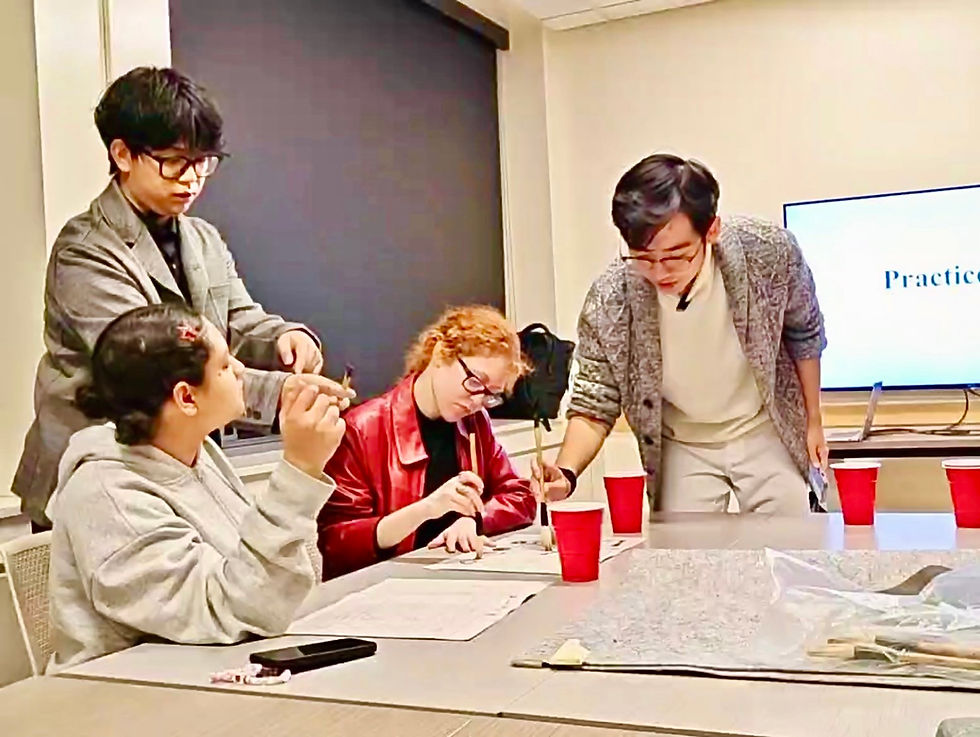Traditional Chinese Calligraphy as Cultural Practice: The Zhengdao Chinese Language Association's Public-Access Course at Binghamton University
The Zhengdao Chinese Language Association maintains an ongoing, publicly accessible course in traditional Chinese calligraphy at Binghamton University, offering community members and students a direct encounter with one of the foundational artistic and intellectual traditions of Chinese civilization.

The Zhengdao Chinese Language Association maintains an ongoing, publicly accessible course in traditional Chinese calligraphy at Binghamton University, offering community members and students a direct encounter with one of the foundational artistic and intellectual traditions of Chinese civilization. This course advances the Association’s mission to preserve the classical writing system, promote cultural understanding, and provide meaningful access to authentic cultural instruction.
Chinese calligraphy is not simply a method of writing; it is a discipline rooted in a philosophy of balance, self-cultivation, and aesthetic refinement. Each character is formed through intentional structure and controlled movement, preserving both linguistic meaning and cultural thought. Through practice, learners discover that the written form is inseparable from rhythm, breath, posture, and concentration — an integrated process that reflects centuries of scholarly tradition.

Script Development and Cultural Continuity
Participants study major historical stages of the Chinese script, including oracle bone inscriptions, bronze script, seal script, and clerical script. Exposure to these forms deepens appreciation for how Chinese characters evolved alongside cultural, political, and spiritual life. Writing is presented not as a static system, but as an enduring record of history, memory, and artistic inquiry.
Instruction and Direct Apprenticeship-Style Learning
A distinguishing feature of this course is its instructional method. The calligraphy instructors do not simply lecture or demonstrate from a distance; they work closely with each participant, offering individual guidance and hand-to-hand correction when needed. Brush placement, wrist relaxation, turning techniques, pressure transitions, and stroke completion are taught through direct observation and personal coaching — a form of transmission rooted in traditional apprenticeship practice.

Learners benefit from rare access to expert guidance that is difficult to find in many contemporary settings. Where most cultural activities today rely on group demonstrations or digital instruction, this course offers patient, individualized support, with instructors standing beside students, adjusting posture, demonstrating finger alignment, and guiding movement slowly and carefully.
Participants repeatedly note that this close guidance — where an instructor’s hand may gently redirect a learner’s brush or stabilize the wrist — reveals nuances impossible to grasp through written instruction or video alone. Such teaching methods allow students to experience the subtle turning of the brush tip, the moment of weight transfer in a stroke, and the quiet stillness required before ink touches paper.

Community-Centered Cultural Access
The course remains free and open to the public, welcoming individuals regardless of prior experience. This accessibility reflects the belief that cultural heritage gains strength when shared widely and practiced sincerely. The classroom environment is welcoming, respectful, and centered on the idea that anyone with interest and patience can enter the world of Chinese calligraphy.
Through this shared practice, participants encounter calligraphy not as a distant cultural artifact, but as a living discipline transmitted through human presence, careful guidance, and steady practice.
Continuing Work
By sustaining this public-access course, the Zhengdao Chinese Language Association offers a meaningful space for cultural engagement and hands-on learning. The work taking place in this room — slow strokes, quiet concentration, ink grinding, brush turning, and one-to-one teaching — demonstrates how ancient knowledge continues to live through personal attention and community participation. The experience cannot be replicated through passive viewing; it must be felt, practiced, and guided in person, one stroke at a time.
_edited.png)





